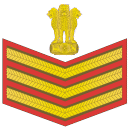Daffadar
- Daffadar
-
Havildar
Havildar est le grade équivalent à sergent au sein de l'armée britannique, juste au-dessus de Naik. Ce grade est toujours utilisé dans les armées indiennes et pakistanaises.
Comme le sergent de l'armée britannique, l' Havildar porte trois chevrons comme insigne de grade. Les Havildar peuvent avoir des fonctions spécifiques (fonctions ouvrant droit à des primes), en dépendant de leur qualification et de leur ancienneté :
- Company Quartermaster Havildar (CQMH), qui assister l'intendant de la compagnie dans la gestion des magasins et entrepôts. L'insigne est alors le même que celui d' Havildar (trois chevrons) avec en plus le lion d'Ashoka au-dessus des chevrons.
- Company Havildar Major (CHM) qui est le sous-officier le plus ancien au sein de la compagnie. L'insigne est un lion d'Ashok porté sur un bracelet de cuir au poignet droit.
- Regimental Quartermarster Havildar (RQMH) et Regimental Havildar Major (RHM). Ces fonctions sont sensiblement identiques à celles ci-dessus, mais au niveau du régiment.
L'équivalent dans la cavalerie et les unités blindées est le Daffadar
Insigne de grade de Havildar
|
Insigne de company quatermaster Havildar
|
Insigne de company Havildar major
|
Catégories : Histoire militaire britannique | Histoire militaire du monde indien | Troupe coloniale britannique | Grade militaire britannique | Grade militaire indien
Wikimedia Foundation.
2010.
Contenu soumis à la licence CC-BY-SA. Source : Article Daffadar de Wikipédia en français (auteurs)
Regardez d'autres dictionnaires:
Daffadar — (Hindustani: दफ़्फ़दार (Devanagari) ; Urdu: دفعدار (Nastaliq)) was the equivalent rank to Sergeant in the cavalry of the British Indian Army, the next rank up from Lance Daffadar. The equivalent in other units was Havildar. Like a British… … Wikipedia
daffadar — dafadar, daffadar variant forms of duffadar … Useful english dictionary
Lance Daffadar — was the equivalent rank to Corporal in British Indian Army cavalry units, ranking between Acting Lance Daffadar and Daffadar. In other units the equivalent was Naik. Like a British Corporal, a Lance Daffadar wore two rank chevrons … Wikipedia
Acting Lance Daffadar — was the equivalent rank to Lance Corporal in British Indian Army cavalry units, ranking below Lance Daffadar. In other units the equivalent was Lance Naik. Like a British Lance Corporal, he wore a single rank chevron … Wikipedia
British Indian Army — Active 1858 – 1948 Country … Wikipedia
Karam Singh (historian) — Karam Singh (1884 1930), pioneer of Sikh research in Sikh history was born on 18 March 1884, the son of Jhanda Singh (a Dhillon Jat), and Mai Bhisan Kaur, at Jhabal village 15 km west of Tarn Taran in the Amritsar district of Punjab. The family… … Wikipedia
Sergeant — For other uses, see Sergeant (disambiguation). Common anglophone military ranks Navies Armies Air forces Officers Admiral of the fleet Marshal / fi … Wikipedia
Lance Corporal — is a military rank, used by many armed forces worldwide, and also by some police forces and other uniformed organizations. It is below the rank of Corporal, and is typically the lowest non commissioned or enlisted rank, usually equivalent to the… … Wikipedia
Naik (military rank) — Naik (sometimes historically called Nayak) (Nk) is the equivalent rank to Corporal in the Indian Army and Pakistan Army, and previously in the British Indian Army and the Camel Corps, ranking between Lance Naik and Havildar. In cavalry units the… … Wikipedia
Lance Naik — (L/Nk) was the equivalent rank to Lance Corporal in the British Indian Army, ranking below Naik. In cavalry units the equivalent was Acting Lance Daffadar. Like a British Lance Corporal, he wore a single rank chevron.This term is still used in… … Wikipedia



